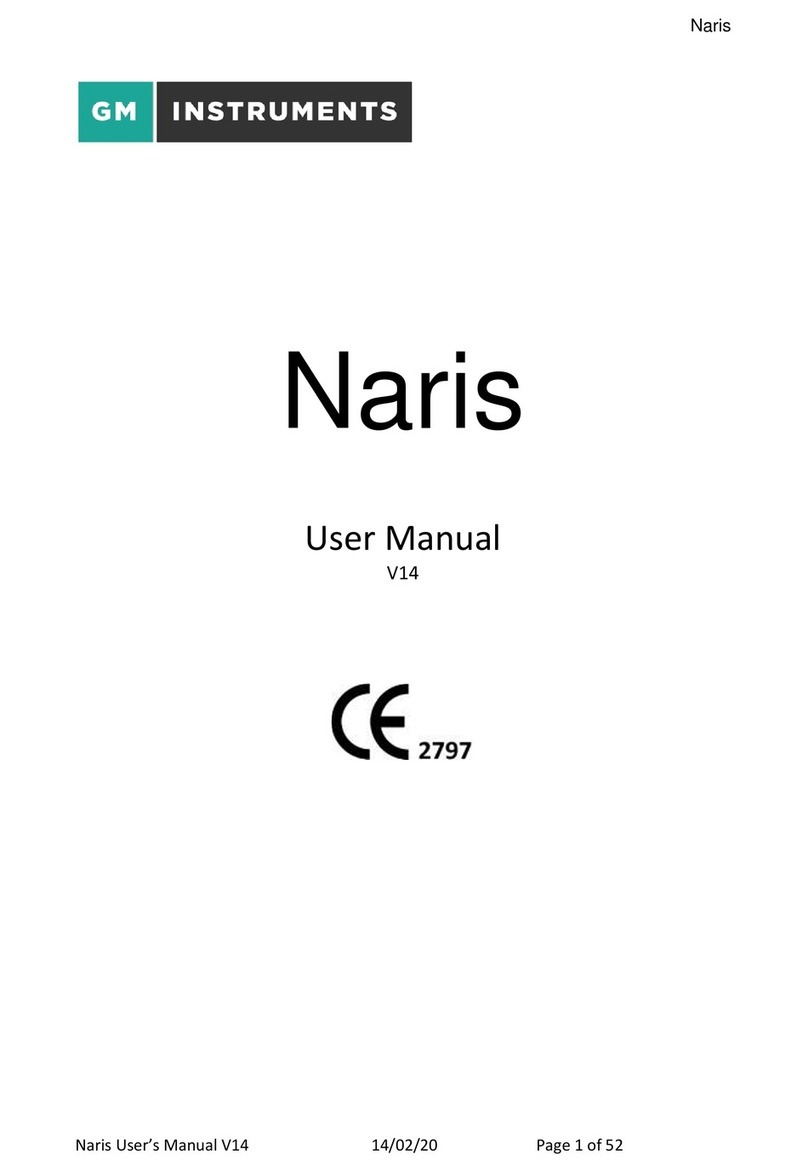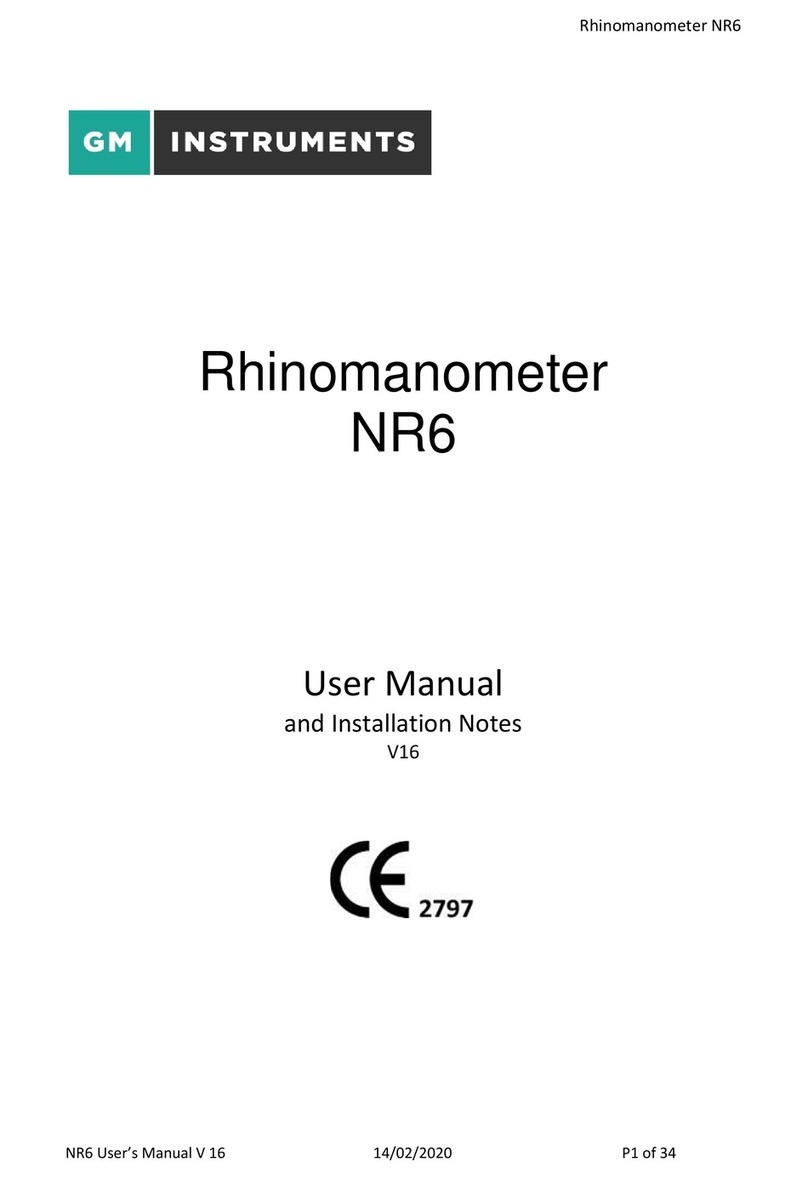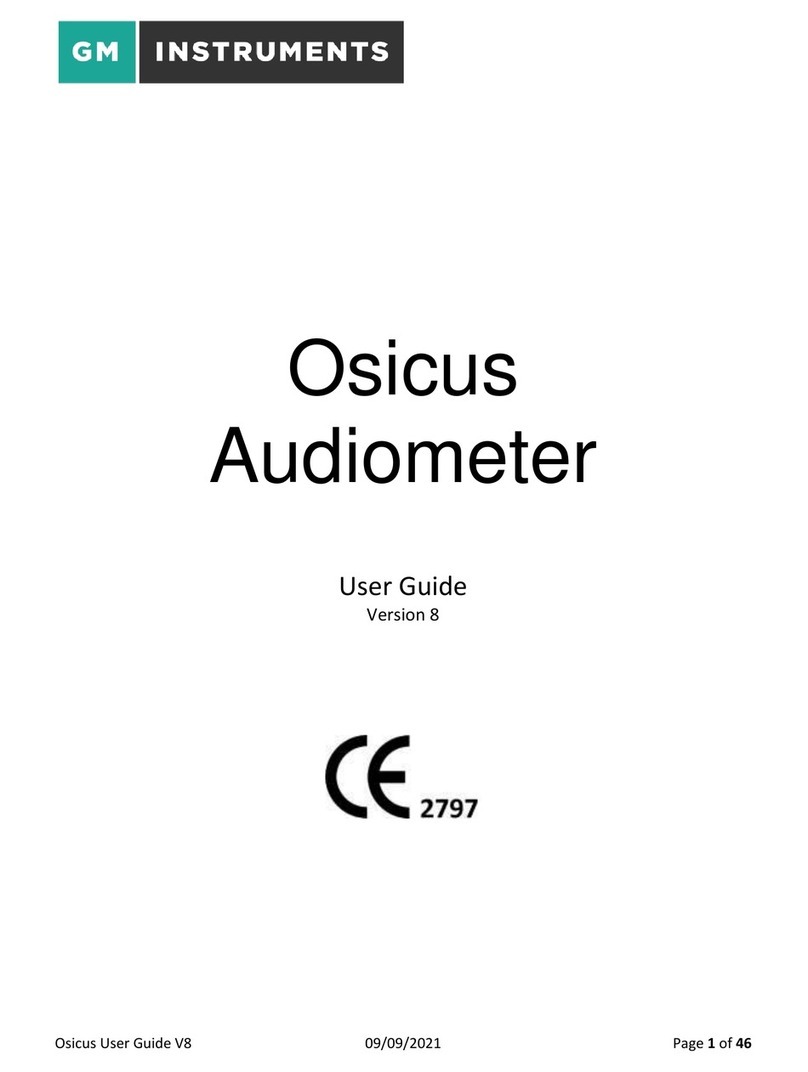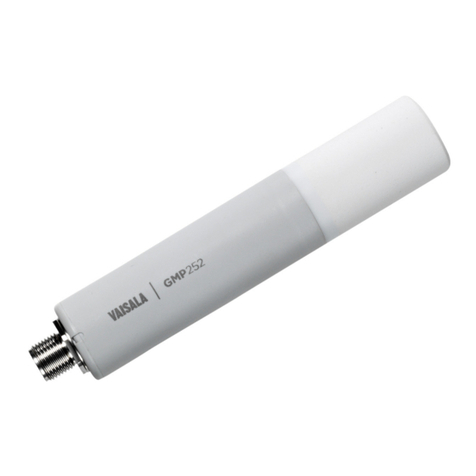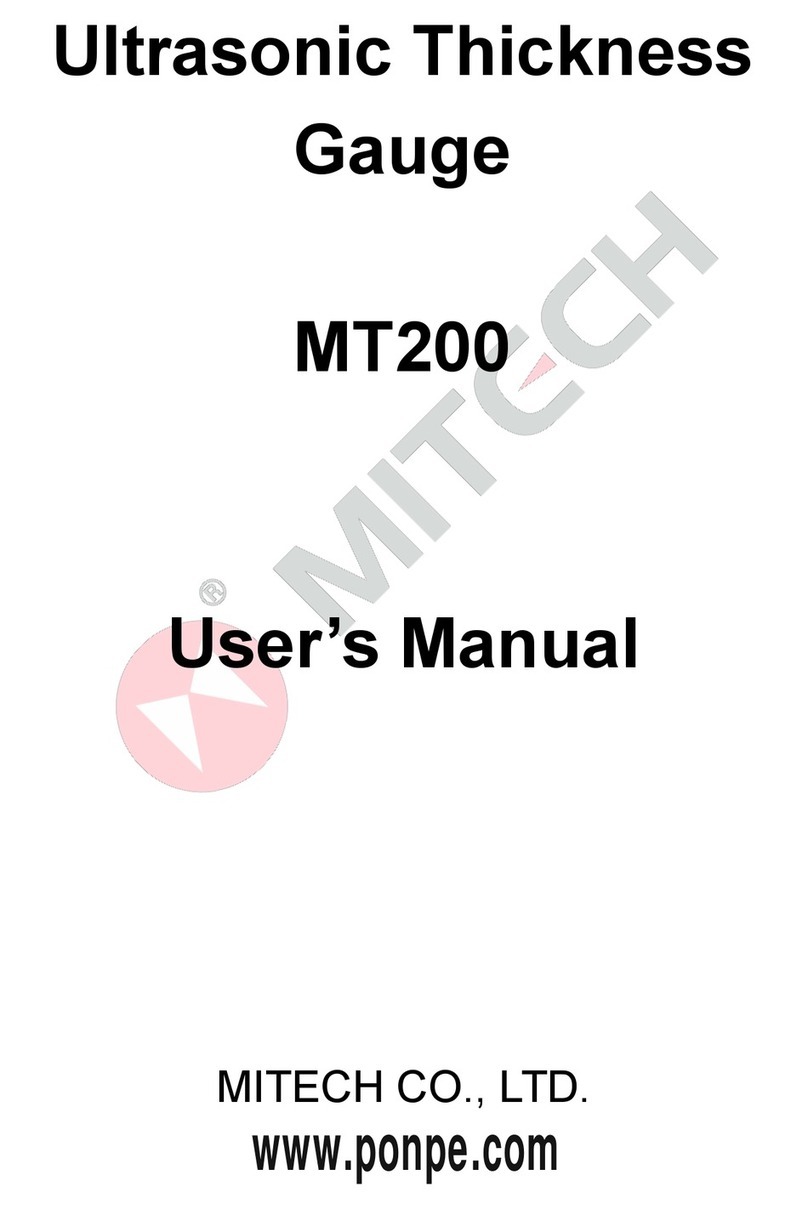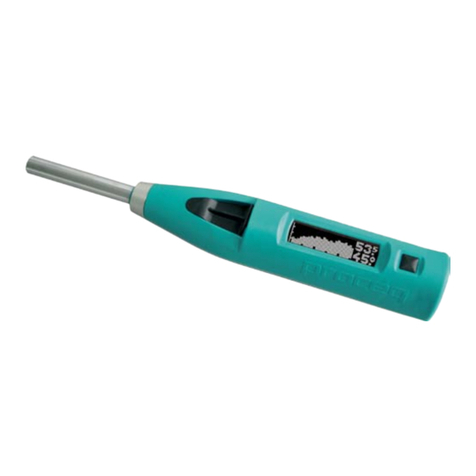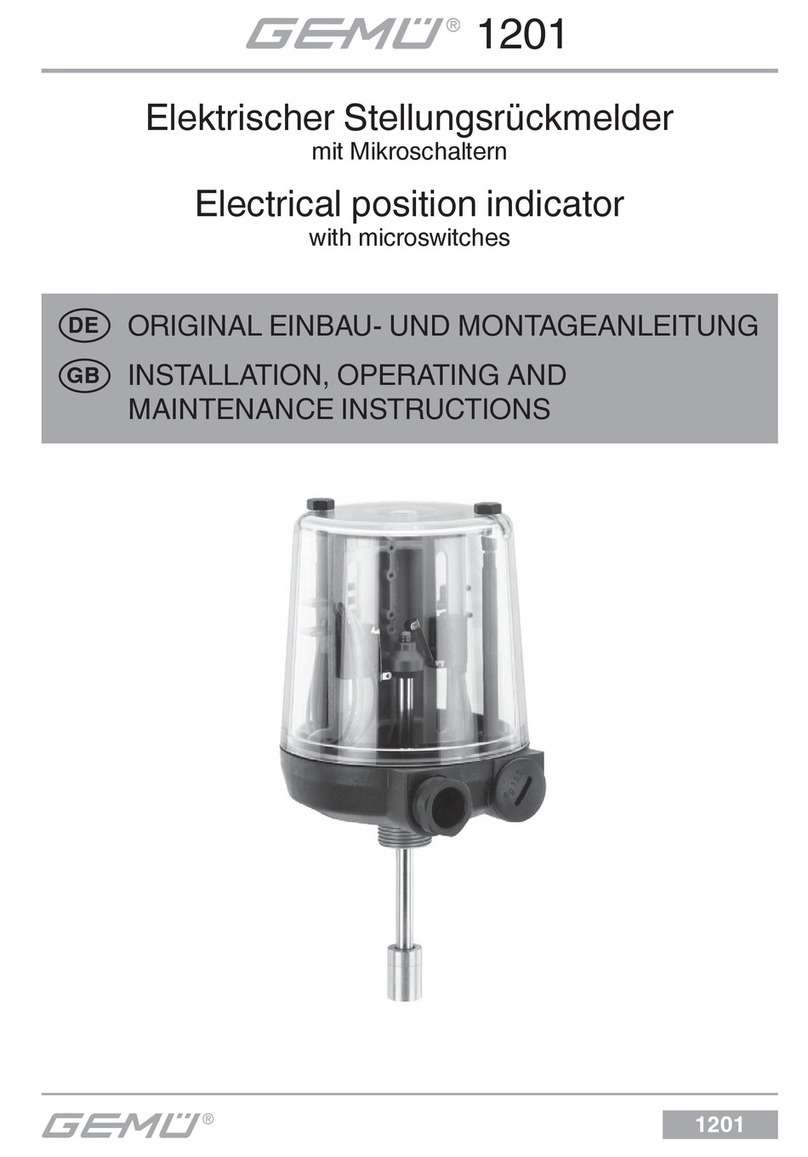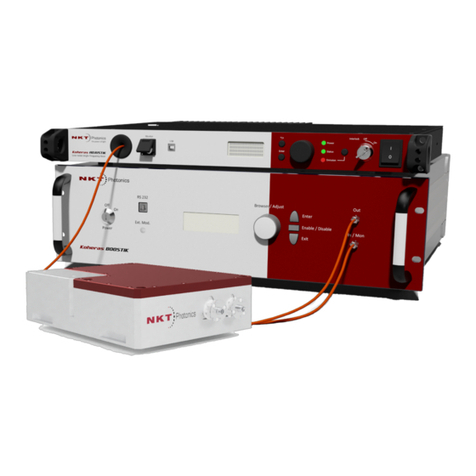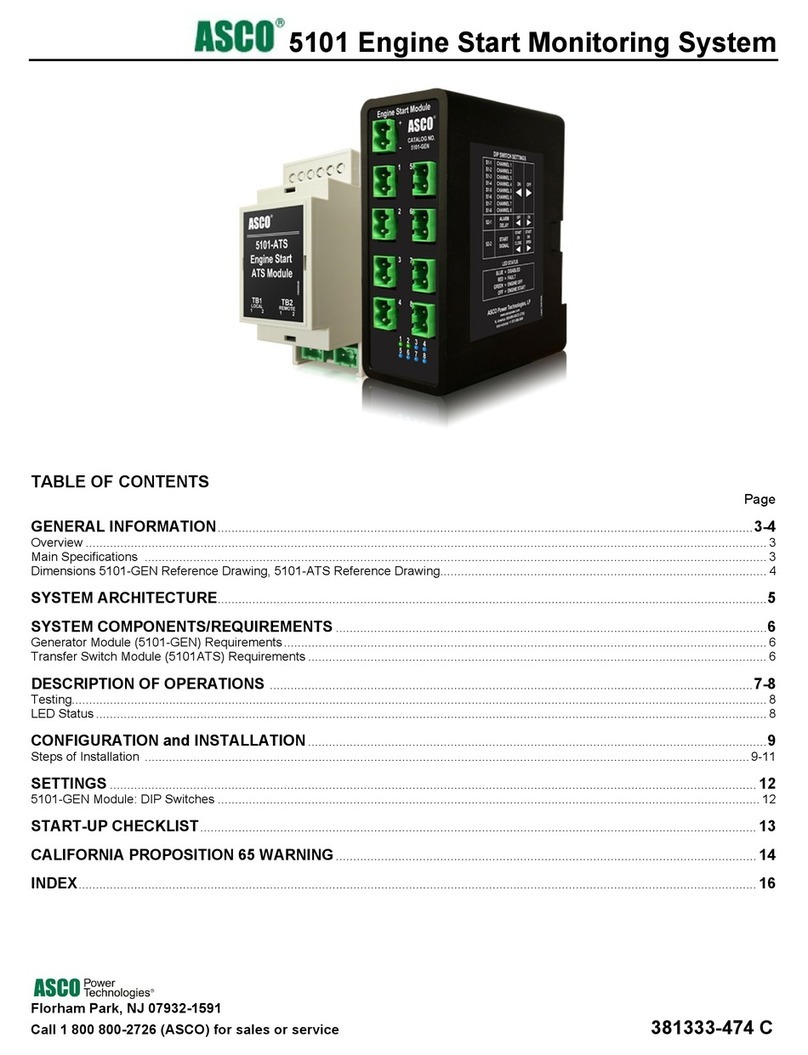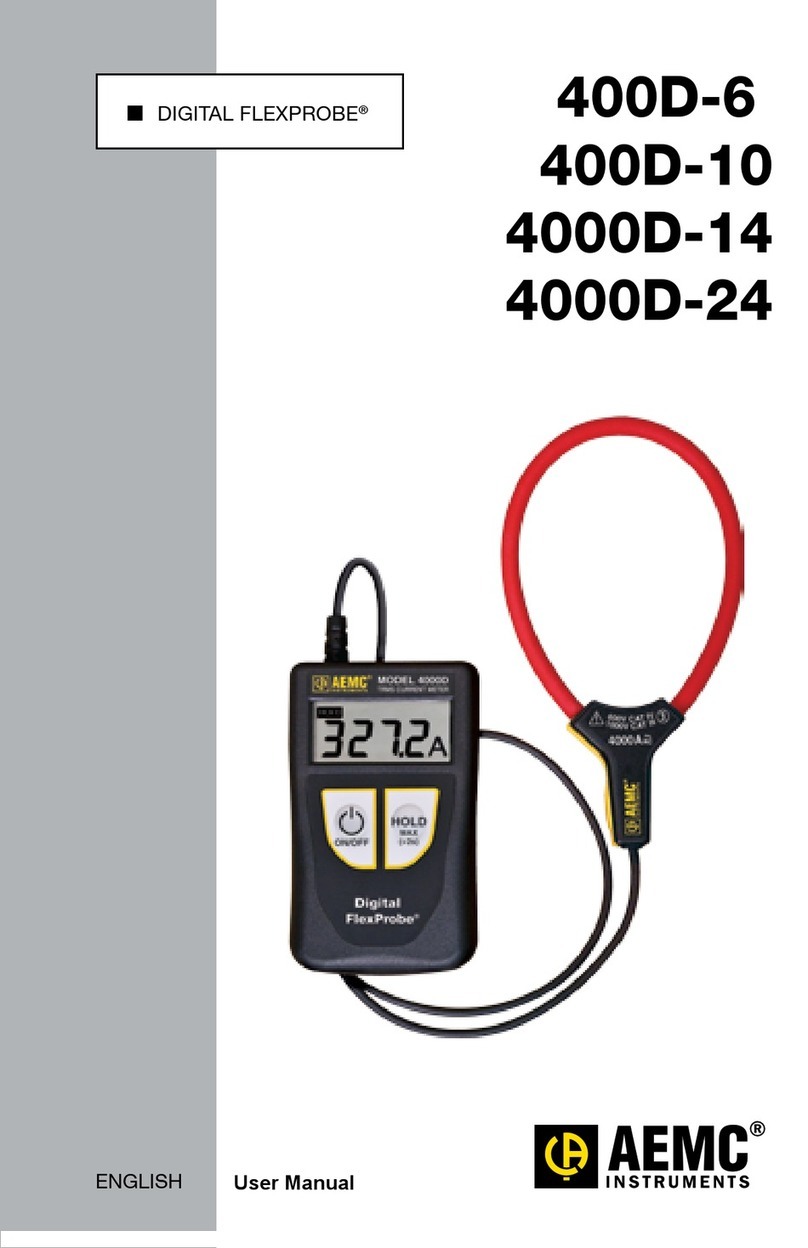GM INSTRUMENTS ASRA User manual

Asra Curve User Guide V9 27/05/2021 Page 1of 40
ASRA Curve
Audiometer
User Guide
Version 9

Asra Curve User Guide V9 27/05/2021 Page 2of 40
CONTENTS
1. Important Safety Information Page 5
Warnings/Cautions Page 5
2. Technical Specification Page 6
3. Symbols Page 8
4. Introduction
General Introduction to the Technique Page 10
5. Installation
5.1. Installing the Software Page 11
5.2. Installing the Drivers Page 14
5.3. Installing the Hardware Page 16
5.4. Check Installation Page 16
6. Initial Setup
6.1. Printouts & Reports Page 18
6.2. Save and Storage Locations Page 18
6.3. Hearing Test Settings Page 19
7. To Make and Record Measurements
7.1. Calibration Check Page 20
7.2. Patient Preparation Page 20
7.3. Introduction Page 21
7.4. The Home Screen Page 21
7.5. Selecting Audiometer Page 21
7.6. Tester Information Page 23
7.7. Patient Details Page 23
7.8. Find Patient Page 23
7.9. Comparison of Audiograms Page 24
8. Running Hearing Test
8.1. Automatic Operation Page 25
8.2. Manual Operation Page 25
8.3. Audiograms and HSE Categories Page 25
8.4. Printing Audiograms Page 27
8.5. Printing Referral Letters Page 27
9. Categorisation of Results Page 28
10. Troubleshooting and Error Messages Page 30
11. Factors which Affect Absolute Accuracy Page 31
12. Maintenance & Technical Information Page 31
13. Calibration Page 31
14. Cleaning Page 32
14.1. Instrument Enclosure Page 32
14.2. Patient Contact Parts Page 32
15. Supplied Parts Page 33
16. Spare Parts & Accessories Page 35
Appendix 1: Guidance on Electromagnetic Environment Page 34
Appendix 2: Technical Information Page 39

Asra Curve User Guide V9 27/05/2021 Page 3of 40
Asra Curve Audiometer User Guide
© 2018 GM Instruments Limited
Reproduction, transfer, distribution, or storage of part or all of the contents in this document in any
form without the prior written permission of GM Instruments Limited is prohibited.
Asra Curve is a trademark of GM Instruments Limited. Other product and company names
mentioned herein may be trademarks or trade names of their respective owners.
GM Instruments Limited reserves the right to make changes and improvements to any products
described in this document without prior written notice.
Under no circumstance shall GM Instruments be responsible for the loss of any data or income or
any special, incidental, consequential, or indirect damages howsoever caused.
The contents of this document are provided ‘as is’. Except as required by applicable law, no
warranties of any kind, either expressed or implied, including but not limited to, the implied
warranties of merchantability and fitness for a particular purpose, are made in relation to the
accuracy, reliability, or contents of this document. GM Instruments Limited reserves the right to
revise this document or withdraw it at any time without prior notice.

Asra Curve User Guide V9 27/05/2021 Page 4of 40
Warranty
This warranty is extended to the original purchaser of the audiometer by GM Instruments Ltd,
through approved Distributors or through GM Instruments Ltd, and covers defects in materials of
workmanship for a period of 1 year from the date of delivery to the original purchaser.
Defects will be corrected at no cost to the purchaser within the first year, except for shipping
charges to and from the point of service. This warranty does not apply to those parts that are
subject to normal wear and tear, such as cords, ear cushions and headbands. Replaceable parts
which may deteriorate with use will be supplied at a reasonable cost.
The manufacturers warranty is void if the audiometer is repaired by persons other than GM
Instruments Ltd or an approved Distributor.
The terms of this warranty do not affect your statutory rights.

Asra Curve User Guide V9 27/05/2021 Page 5of 40
1. ASRA Curve Audiometer Important Safety Information
Read this Operating Manual before attempting to use the Instrument.
Warnings
This Instrument is for indoor use only and it should only be used as described in this manual.
The system must not be used in the presence of flammable gases or in an environment, which is
susceptible to explosions. (Beware of oxygen, dust, and anaesthetic gases)
This unit is powered by the mains adaptor supplied and is specified as part of the equipment. It is
advisable not to touch the patient while using the equipment.
The equipment should be positioned in such a way that it can be easily disconnected from the mains
supply. The operation of the system can be safely terminated by switching off or removing the mains
plug.
If your desktop PC or printer does not have a power supply approved for a patient environment,
then an isolation transformer, which is in compliance with BS EN 60601, should be used to power
the PC, printer, and the ASRA Curve. You must use the isolation transformer to ensure that the ASRA
Curve is in compliance with BS EN 60601.
Applied Parts. The Applied Parts are the headset and the response button.
CAUTIONS
Federal (USA) law restricts this device to sale by or on the order of a physician.
The use of the ASRA Curve near to sources of electromagnetic radiation, such as mobile phones,
radio transmitters, x-ray equipment etc, may prevent it from functioning correctly. Appendix 1
provides guidance on the Electromagnetic environment in which to operate the instrument.
This is a medical instrument, which has an electrical classification of Class 2 Type B and a Medical
Device Directive classification of Class IIa.
A Class II Type B device categorisation is used to describe an instrument which: -
a) Electrical equipment in which protection against electric shock does not rely
on BASIC INSULATION only, but in which additional safety precautions such as DOUBLE
INSULATION or REINFORCED INSULATION are provided, there being no provision for protective
earthing or reliance upon installation conditions and
b) Applied parts offer protection to the subject against electrical shock and in the event of a single
fault condition arising, leakage current will be limited to less than 0.5 mA.

Asra Curve User Guide V9 27/05/2021 Page 6of 40
Any incident, which results in actual or potential injury or death to a subject while using the ASRA
Curve should be immediately communicated to GM Instruments at the address below.
The ASRA Curve should only be connected to other mains powered devices such as computers and
printers, which comply with EN 60950-1 and we also advise the use of a separating transformer.
Unless computers and printers built to EN 60950 are used, patient safety might be compromised.
Non-medical equipment such as computers and printers should be kept out of reach of subjects
being tested as such equipment does not comply with medical safety standards. Refer to clause 16
of EN 60601-1:2006 to ensure compliance.
If the PC is allowed to go in to sleep mode, the USB interface is powered down. When brought out of
sleep mode, the PC does not re-initialise the USB interface, and it is effectively not present. A solution is
to remove the USB connection at the PC or instrument side then reconnect. That may be sufficient, but
if not, save any results, close down the instrument software, and restart it
Servicing can only be carried out by GMI approved and authorised
personnel. No modifications are allowed.
2. Technical Specification
Factory-trained personnel or engineers familiar with the standard EN 60601 can only undertake
servicing of the ASRA Curve Audiometer. Circuit diagrams will be made available to competent
persons on request.
Medical CE
Mark
The CE mark indicates that the device meets the requirement of Annex V & VII of
the Medical Device Directive 94/42/EEC. Approval of the Quality System is made
by BSi whose notified body number is 2797
Standards
Safety
BS EN 60601-1 Class 2 Type B applied parts
EMC
BS EN 60601-1-2
Audiometer
BS EN 60645 -1, Type 4
Categorisation
UK & Ireland H&SE
Operation
Environment
Temperature
15°C to 35°C
Relative Humidity
30% to 90%
Ambient Pressure
98kPa to 104kPa
Warm up time
5 Minutes
Transport &
Storage
Storage
&Transport
Temperature
-40°C to +60°C
Relative Humidity
30% to 90%
Supply Power
Supplied PSU
Use only specified PSU VEP15US09 *
Line Voltage
100V to 240 V at 50-60 Hz
Consumption
12.6W
Tone Type
Tone switching
-Tone Presentation
-Tone Interruption
Automatic Mode

Asra Curve User Guide V9 27/05/2021 Page 7of 40
Tone Switching
-pulsed
Manual Mode
Response
Required during TONE or as set by the user from the
Options menu
Frequency
Range
Discrete
Frequencies and
Maximum
Outputs
125Hz (75dB),250Hz (90dB),500Hz (120dB), 750Hz
(120dB),1KHz(120dB),1.5KHz(120dB),2KHz(120dB),
3KHz(120dB),4kHz(120dB),
6KHz(110db),8KHz(110dB),
12KHz(110dB)
Accuracy
± 0.1 %
Total
Harmonic
Distortion
± 1.0 %
Test Type
Auto
Threshold
Determin
ation
Hughson Westlake
Intensity
Range
-10 dB to +120dB
Accuracy
± 1.0 %
Rate of Change
40 m secs
Duty Cycle
Continuous
Intensity Limit
To have tones presented at 100dB or above then a
positive response from the operator is required
Headset
Earphones,
Cushions & Audio
cups
TDH39P * (10 Ohm impedance) with MX41/AR Cushions and
Amplivox AO22Audio cups
Mechanical
Dimensions
22x 23 x 4 cm
Weight
1 Kg
Calibration
Frequency
Annual calibration required by Manufacturer or Manufacturer
approved provider
Method
ISO 8253-1 Calibration undertaken using Referenced
Transducers and Acoustic Coupler –see calibration certificate
supplied
EMC
Effects
Please refer to pages 34 to 38 of this manual (Appendix 1)
Service Life
Safety and
Performance
The service life of the ASRA Curve has been evaluated to be 10
years from the date of manufacture.
Additional Technical Information (relative to EN 60601-1:2006) is also provided in Appendix 2

Asra Curve User Guide V9 27/05/2021 Page 8of 40
3. Table of symbols used
The following symbols appear on the ASRA Curve or the mains adaptor
Symbol
Meaning
Socket Type
Location
Connected Part
Refer to Instruction
Manual
ISO 7010-M002
USB Type B
Instrument Back
Panel
Computer (Via
USB Port)
2.5mm DC Jack
Socket
Instrument Back
Panel
Mains AC/DC
Adaptor
VEP15US09*
Type B
Applied Parts
IEC 60417- 5840
Jack Plug
Instrument Back
Panel
Right and Left
Input Socket
Response Button *
Direct Current
IEC 60417 - 5931
_
Mains Adaptor
AC/DC
VEP15US09 *
For connected parts marked * only connect the accessories supplied with the
instrument. These parts have been tested for use with the instrument for
compliance to standards IEC 60601-1 and IEC 60601-1-2.
Symbols used on labelling and packaging
Symbol
Meaning
Location
Manufacturer
ISO 7000-3082
Instrument Label
Serial Number
ISO 7000-2498
Instrument Label
Consult Instructions for Use
ISO 7000-1641
Instrument Label
0000
Council Decision 93/465/EC. Annex B(d)
Instrument Label
Date of Manufacture
Where ZZZZ: Date ofManufacture
ISO7000-2497
Instrument Label

Asra Curve User Guide V9 27/05/2021 Page 9of 40
Temperature Limit
ISO7000-0632
Instrument Shipper
Packaging
Humidity Limitation
ISO7000-2620
Instrument Shipper
Packaging
Atmospheric Pressure limitation
ISO7000-2621
Instrument Shipper
Packaging
Mandatory Action Sign
ISO 7010- M001
Operating Manual
Authorized Representative in the European
Community
Instrument Shipper
Packing & User Manual
Address and Contact Details:
MANUFACTURED BY: AUTHORIZED REPRESENTATIVE:
GM Instruments Ltd Advena Ltd
Block 1 Annickbank Innovation Campus Tower Business Centre, 2nd Flr
Annick Road Tower Street
Irvine Swatar
KA11 4LF BKR 4013
UK Malta
TEL: +44 (0)1294 554664
WEBSITE: www.gm-instruments.com

Asra Curve User Guide V9 27/05/2021 Page 10 of 40
4. Introduction
The ASRA Curve Audiometer is a medical device used to screen subjects for noise induced hearing
loss.
It is intended that the ASRA Curve will be used as part of a hearing screening program in industrial
and corporate environments. The hearing screening will measure the hearing threshold of a test
subject
and indicate the need for further clinical analysis and treatment. The ASRA Curve is a stand-
alone product andis not intended to be used with other medical devices.
The operator of the ASRA Curve is expected, as a minimum, to be a competent person. Competent
persons have completed courses with syllabi determined by the British Society of Audiology. These
courses
familiarise them with audiology, the methods of performing hearing testing and how to
operate and maintain audiometers. Other users may be more skilled experts in audiology, such as
Occupational Health nurses and audiologists.
The subject, upon whom the hearing testing is performed, is expected to be an employee working in
high-noise environments being screened in line with the Health and Safety Executive’s regulations
on noise at work or being routinely screened as a part of a workplace health programme.
Subsequently, theycome
from all walks of life and are of working age.
The ASRA Curve audiometer is expected to be used in an environment suitable for the conduction of
hearing testing. Most likely a quiet office or a room fitted out with a hearing testbooth.
The process follows the British Society of Audiology approved procedures for the determination of
Pure Tone thresholds, using the Hughson Westlake technique. The headphones rest on the outside
of the head of the test subject and shall transfer sound energy to the
subject by air conduction. The
subject holds the remote switch and presses it when tones are heard.
Once thresholds have been determined for both ears on selected frequencies, and the age and
gender of the subject being tested has been input, the audiogram is categorised according to the
Health & Safety Executive categorisation scheme.

Asra Curve User Guide V9 27/05/2021 Page 11 of 40
5. Installation
5.1 ASRA Curve Program Installation
NB: Do not connect Asra to the PC until all program software and USB driver software installation
has been completed.
SOFTWARE (Windows 10 and earlier)
If your PC is password protected and/or network connected, you should log on with administrator
rights prior to loading the software.
The Asra software and USB drivers are supplied on a USB drive and can be installed by inserting the
USB drive into the computer, navigating to it, and right clicking on the file Asra.EXE, and Run as
administrator.
The Asra files will be unpacked and installed on the C drive in a folder called ASRA Curve.
If necessary, the files can be transferred to a network drive.
Care should be taken in installations where a number of users have their own login, to ensure that
the two Asra programs are available to all who may need to use them.
When prompted “Do you want to allow the following program from an unknown publisher to make
changes to this computer?”, click yes and continue.
In the set-up window, follow the instructions on screen to the next step.
The default directory for the program is in C:\Program files (x86)\ASRA Curve, check and click next to
proceed to the next step.
For correct operation, the drivers should be installed before connecting the audiometer to the
computer.
The next stage allows selection of the components to be installed with the ASRA software, all
components should be selected for installation before proceeding.

Asra Curve User Guide V9 27/05/2021 Page 12 of 40
The next stage will prompt to create a shortcut to the Asra Curve program in the Start Menu folder,
press Next to confirm.
At the next stage, review the setting before clicking next and continuing with the installation.

Asra Curve User Guide V9 27/05/2021 Page 13 of 40
Click on Finish to complete the installation.
The installation of the ASRA software is now complete. If it is necessary to change the default save
and passive directory locations, this can be within the main program and then using Exit to save as
the new default.
It is recommended that icons for ASRA Curve (ASRA Curve testing program) and Batch Processing
Utility (ASRA batch utility program) be made available on each person’s desktop. To do this open the
start menu and open the folder named ASRA Curve. Next, right-click on the ASRA Curve program
icon and select ‘More’followed by ‘Open File Location’. Click and drag the shortcut icon that comes

Asra Curve User Guide V9 27/05/2021 Page 14 of 40
up onto the desktop. Repeat the process for a folder called ASRA Osicus Batch_Utility to put the
Batch_Utility shortcut onto the desktop.
5.2 ASRA Driver Installation
To install the Asra Curve drivers, right click CDM21228_Setup.exe and select Run as Administrator.
In the setup window, follow the instructions by click next to start the installation
In the following window, select acceptance and then next to confirm the License Agreement and
continue.

Asra Curve User Guide V9 27/05/2021 Page 15 of 40
Once the installation has completed click on ‘Finish’, then close down and restart your computer.

Asra Curve User Guide V9 27/05/2021 Page 16 of 40
5.3 Installing the Hardware
Operation of the ASRA audiometer is controlled by software running on a Windows based
PC.
The link between PC and Asra Curve is by means of a standard USB cable.
The other connections on the back of Asra Curve, which are essential for its correct operation
are:-
•Power supply cable –check the LED on the front of Asra Curve to show that it is lit when
mains power is switched on.
•Right (red) earphone plug - if a booth is used, link the socket marked right on the back of
Asra to the red socket on the booth and connect the red earphone plug to the
corresponding red socket inside the booth. If no booth is available, connect the red plug
directly into the socket marked right.
•Left (blue) earphone plug - if a booth is used, link the socket marked left on the back of
Asra to the blue socket on the booth and connect the blue earphone plug to the
corresponding blue socket inside the booth. If no booth is available, connect the blue
plug directly into the socket marked left.
•Response button plug –if a booth is used, link the socket marked response on the
back of Asra Curve to the black socket on the booth and connect the response
button plug to the corresponding black socket inside the booth. If no booth is
available, connect the response button plug directly into the socket marked response.
Operation can be confirmed by pressing the button and checking the response LED lights.
5.4 To Check Installation
•Close down PC and log on as an ordinary user
•Check the two Asra icons are on the desktop
•Double-click on each icon in turn to check that both programs run
•In the Asra Curve testing program select New Test and confirm that the headphone serial
numbers match with the headset plugged into the Asra Curve
•From the dropdown menu labelled Test, select Manual, and, put on the earphones and click
the Tone button to present a tone
The Tone On light should illuminate and a tone should sound.
If the response button is pressed while the tone is sounding the small cursor on the
screen should become large to show that the response has been accepted, the Tone On

Asra Curve User Guide V9 27/05/2021 Page 17 of 40
light should go out and the Response light should turn on and the message “RESPONSE”
appears in the bottom righthand corner of the program window.
Click on Stop to return to normal operation.
•Click on print to check the operation of the printer.
The system is now ready for use!

Asra Curve User Guide V9 27/05/2021 Page 18 of 40
6. Initial Setup
6.1 Printouts & Reports
The headers on the audiogram printouts can also be customised by clicking the Reports tab within
the settings window and editing as required and then clicking the Save button.
6.2 Save & Storage Locations
The default Active save, and Passive storage locations are set in the program on installation. These
can be edited to any location on the PC or a network location defined by the User. This can be
changed by selecting the Settings tab on the home screen and then Storage in the new window.

Asra Curve User Guide V9 27/05/2021 Page 19 of 40
The location can be changed by click the blue folder icon, and navigation to the desired location
using the Browse For Folder window. To select, press OK and the Save when finished to make the
new destinations default in future.
6.3 Hearing Test Settings
The default settings for the hearing test are shown when the Hearing Test tab is selected and are
shown below.
The menu allows the test frequencies, tone duration, starting intensity and side, and either
continuous or pulsed tones to be selected.
The default settings are:
•Tone duration –1.5 seconds
•Starting Intensity - 40dB
•Starting Side - Left
•Test Frequencies –1, 2, 3, 4, 6, 8, 0.5 kHz
•Tone mode –Continuous
Once changes have been made, select Save to confirm and set as default for testing.

Asra Curve User Guide V9 27/05/2021 Page 20 of 40
7. Making and Recording Measurements
The Asra can be used by any “competent person”, technician, nurse, or doctor, who has been
certified as having satisfactorily completed a competent person’s audiology course.
Having become familiar with the hardware and software you are now ready to record
measurements.
7.1 Calibration check
It is recommended that a calibration check is carried out at the beginning of the day prior to
patient testing to confirm Asra Curve performs as expected.
To do a calibration check, switch on the Asra Curve, start the software and move to the testing
screen. Enter Patient ID details if you want to save the calibration check.
Then either put the headset on an “artificial ear”, with the response cable replacing the
response button unit or ask someone whose hearing level is known to put on the headset
(remove glasses and earrings if they interfere with the fit of the headset). Advise them to
press and release the button as soon as they hear the tone.
The red audio cup goes on the right ear and the blue audio cup on the left ear. Click on the Test
button to start the test.
On completion compare the audiogram with the previously recorded audiogram for that “artificial
ear” or test person.
It is always possible for any threshold point to move up or down by 5 dB, but if almost all points
are further down the audiogram from previous results, the jack connections inside the booth
and outside the booth (if a booth is being used), plus the jack connections at the back of the
Asra should be cleaned with an alcohol wipe and swiped in and out 10 to 20 times to clean them.
The test should then be repeated. If this does not restore the thresholds, then a cable
problem might exist on the ear in question.
7.2 Patient Preparation
The patient should be prepared, prior to testing, by having them in a quiet stable environment
for 5 to 10 minutes. This is a suitable time to take their history, complete your pre-test
questionnaire and examine the ears for wax.
If they have recently been exposed to excessive noise, or have a cold prior to this appointment, a
note to this effect can be made in the comments section of the program.
Table of contents
Other GM INSTRUMENTS Measuring Instrument manuals
Popular Measuring Instrument manuals by other brands
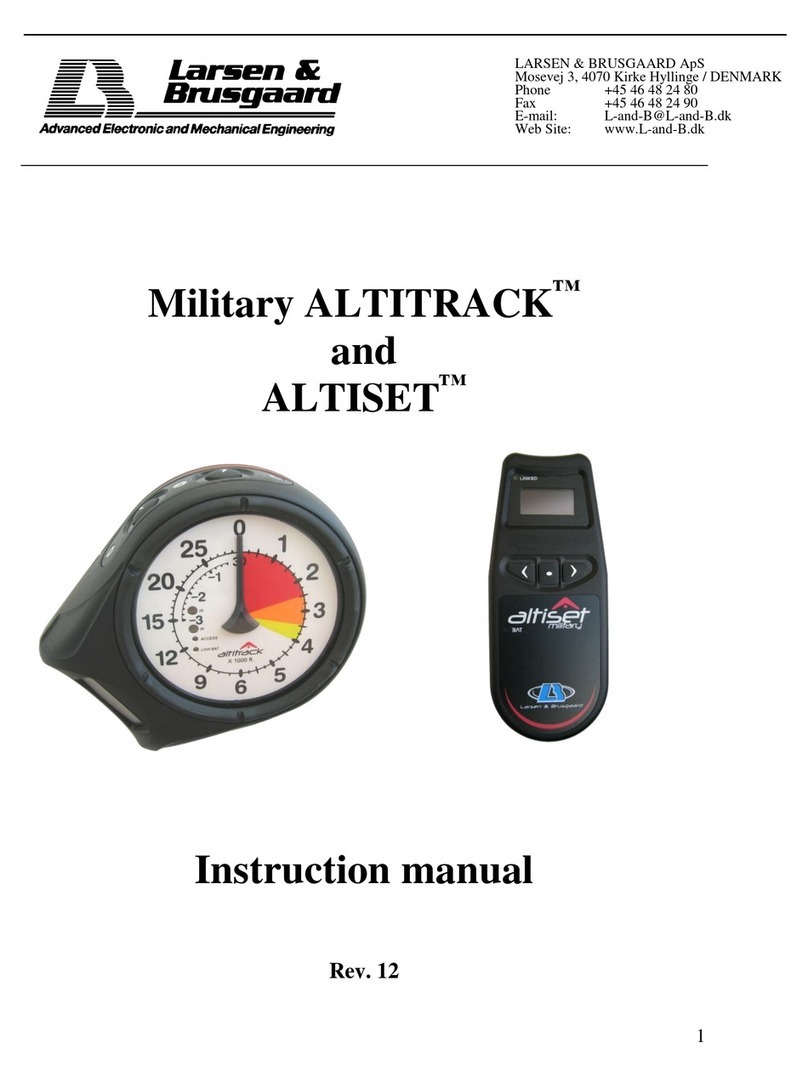
Larsen & Brusgaard
Larsen & Brusgaard Military ALTITRACK instruction manual
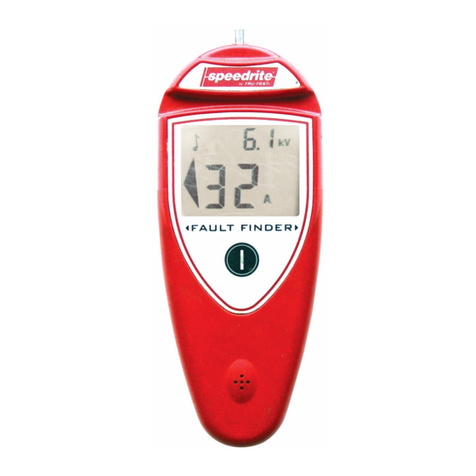
Speedrite
Speedrite Fault Finder Handset user manual
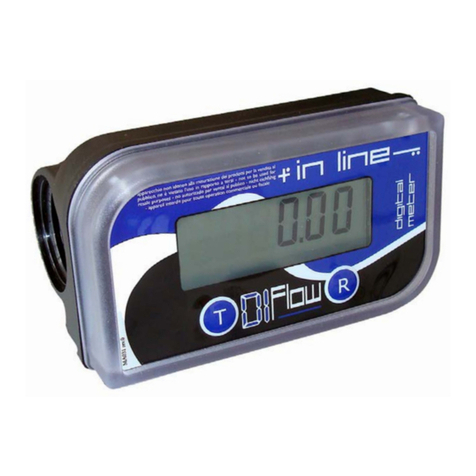
Adam Pumps
Adam Pumps DI-FLOW IN-LINE Diesel Use and maintenance manual

Rice Lake
Rice Lake REVOLUTION Tracer AV installation manual
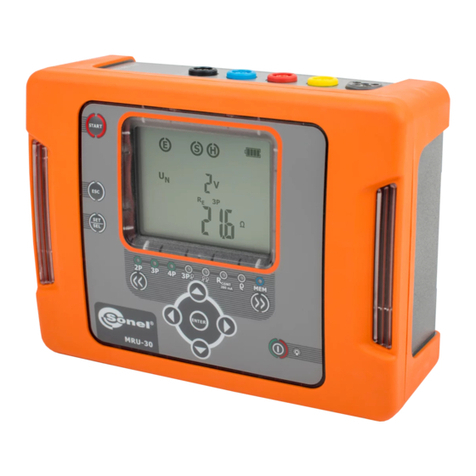
Sonel
Sonel MRU-30 user manual
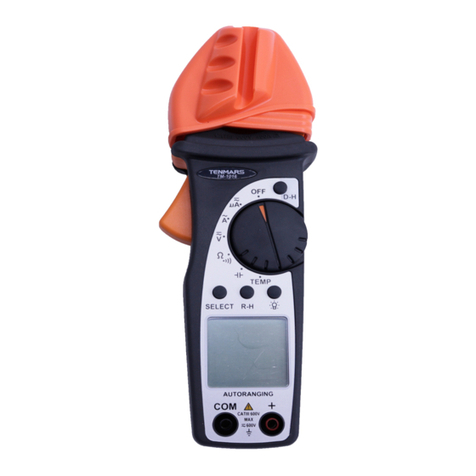
Tenmars
Tenmars TM-1016 user manual
